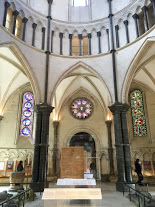The Customary and Religious Law Interest Group (CARLIG) met on July 19 at 11:30 as part of the FCIL-SIS Jurisdictions Interest Groups Joint Meeting. The group briefly discussed the year’s progress, which included acquiring approximately 35 members in My Communities, developing several programming proposals for the 2015 conference, and publishing an article in AALL Spectrum describing the group’s formation, purpose, and goals. The majority of the discussion then focused on 1) improving communication with the group’s membership in order to generate better response to the My Communities posts; 2) increasing the number of blogging and book review opportunities on customary and religious law topics and soliciting participation by the group’s members; and 3) developing and prioritizing additional projects for the coming year.
CARLIG intends to continue proposing conference programming, and brainstormed a few ideas for the 2016 conference. The group discussed the possibility of putting together a panel of librarians and researchers who are currently working on comprehensive online portals or printed bibliographies of religious law resources. Kelly Buchanan, of the Library of Congress, also shared some preliminary information relating to an Islamic law program to be held at the Library of Congress in December. The group discussed potential opportunities for collaboration between CARLIG and the Library of Congress staff, which has been working on increasing the number of available customary law and religious law resources.
In addition to planning substantive programming, the group decided that CARLIG’s primary focus over the upcoming year should be to create teaching/research toolkits for customary law and for each of the major religious law systems. The purpose of these toolkits will be to encourage more librarians to incorporate customary and religious law research into their FCIL research classes or their presentations in substantive law classes. CARLIG will also work on some of the ideas proposed at the 2014 conference, including creating bibliographies of core resources for use in collection development, and identifying the major library collections in customary law and in each of the major religious law systems.

 of Magna Carta, the revolutionary charter between King John I and his barons often cited as the foundation of basic Anglo-American concepts of protected liberties, rule of law, and good government. There have been many events planned to commemorate its importance this year, and I was fortunate enough to be able to see two of the best: the traveling Lincoln Cathedral manuscript and related exhibit at the Library of Congress in December, and the magnificent display of multiple manuscripts at the British Library last month.
of Magna Carta, the revolutionary charter between King John I and his barons often cited as the foundation of basic Anglo-American concepts of protected liberties, rule of law, and good government. There have been many events planned to commemorate its importance this year, and I was fortunate enough to be able to see two of the best: the traveling Lincoln Cathedral manuscript and related exhibit at the Library of Congress in December, and the magnificent display of multiple manuscripts at the British Library last month.
